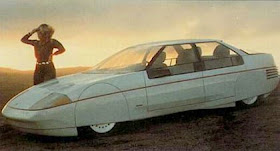What will personal transportation look like in the future, four years ago, in 2010? Peter Hyams has his own ideas regarding the issue.
The cars, or rather the
car of
2010: The Year We Make Contact is seldom mentioned. Perhaps it is because only one single car is seen driving in the movie, and it is seen only once. (A television advertisement for Sheraton hotels shows people exiting a DeLorean for a couple of seconds, but it is merely ancillary.) In any case, this article tries to rectify the lapse.
 |
| Design concept for the concept car. |
Science fiction and fantasy movies often have specially made
ad hoc cars and other vehicles, novelty items created by the prop department specifically as props for the movie. Not so in
2010. The car in question is an actual, driveable, real,
bona fide car, created by a third party. What is this mystery car, then?
The car is a Ford Probe IV Concept Car, built in 1982/1983 by the Ford motor company. Ford launched a Probe model in 1989, but this vehicle is a completely different beast. The Ford concept cars were never meant to be templates for production models, but rather feasibility studies. Car companies made and still make concept cars, often outrageous designs never even remotely considered for production, but rather as eye catchers at shows. The Probe however was different. Fully operational and innovative, is was conceivably the most advanced concept car Ford ever made.
As is apparent from the model number - the roman numeral IV - there should have been three previous concept cars, right? Wrong. The Probe II Concept Car was never made, and number 1 obviously never had a number. In addition Probe III was only targeted for European markets and was a creation of Ford Europe. This means Probe IV was, despite the numeral, essentially the second general Ford Concept Car.
 |
| 1983 promotional picture for the concept car with wheel strakes clearly visible. |
Probe IV was created after the 1979 Oil Shock, a largely manufactured energy crisis that never the less had real world repercussions. For the first time aerodynamics and fuel efficiency were brought to the forefront in car design. Car designs prior to the '79 crisis fundamentally looked like barges compared to the sleek, arrow-like designs that came after it.
Looking Forward
Probe IV was the epitome of aerodynamic thinking of the day. One of the most striking features of the design are the urethane wheel enclosures, created to minimize wheel well turbulence and to reduce drag. The membrane 'skirts' bulged and shifted with the wheels when turning the vehicle, reducing aero drag remarkably. There were other innovations in the design, as well. The undercar airflow was reduced by a streamlined belly pan and strakes in front of and behind the wheels. The front headlights were housed in a cone-like plastic casing. The seats were molded sling seats to reduce roof height while maintaining driving comfort. The windscreen had a wind spoiler at the base, and even the emblems and logos were flush with the car surface. In fact, the entire car changed posture when driving at higher speeds: the front end could 'dip' four inches, and the rear end could be raised up to six inches, all to create a more aerodynamic driving profile. As a result, Probe IV had a Cd (
drag coefficient for the un-initiated) of 0.152, the same as an F-16 fighter jet.
 |
| The only car in the movie. |
There are not many outdoor scenes in the movie at all. Perhaps that is why the Probe is so visible. Being photographed from the front, alert viewers can also notice the strangely thin tires of the vehicle, thin discs that almost look like bicycle tires. The thinness is not due to any optical illusion: the tires were P155/75R-16 LDC thin profile tires with a low drag tread pattern specially-developed by Goodyear for the Probe IV to reduce drag and raise fuel efficiency.
Looking Further
According to production designer Albert Brenner, director Peter Hyams requested the Ford because "he wanted the most advanced design car he could find." However, one little detail seems to suggest that even the advanced Probe was a bit too limited.
When the car passes the viewer, the distinct humming of an electric motor can be heard. The Probe IV however made no such sound; the scene was in fact shot silent and all the dialogue and audio effects, including the electric hum, were added in post-production by Richard Anderson's sound department. The Probe IV was after all powered by fossil fuel. A turbo-charged 1.6 liter engine, tilted almost flat to reduce hood height, but a fossil fuel engine never the less. Electric it was not.
While the Probe IV was a very forward-thinking vehicle, with plenty of clever designs, it seems director Peter Hyams wanted to go one step further.
Images copyright ©1982-1983 Ford Motor Corporation, ©1984 MGM.







